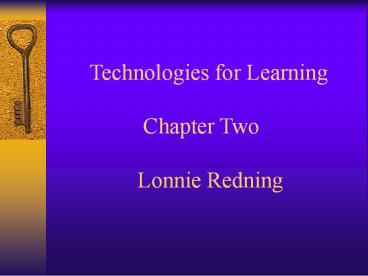Technologies for Learning Chapter Two Lonnie Redning - PowerPoint PPT Presentation
Title:
Technologies for Learning Chapter Two Lonnie Redning
Description:
Technologies for Learning Chapter Two Lonnie Redning Objectives State different types of learning technologies Describe advantages and disadvantages to each Common ... – PowerPoint PPT presentation
Number of Views:114
Avg rating:3.0/5.0
Title: Technologies for Learning Chapter Two Lonnie Redning
1
Technologies for Learning Chapter Two
Lonnie Redning
2
Objectives
- State different types of learning technologies
- Describe advantages and disadvantages to each
- Common features of effective instruction.
3
Effective Instruction
- Active Participation Interaction
- Practice
- Individualized Instruction
- Reinforcement or feedback
- Realistic context
- Cooperative Groups.
4
Cooperative Learning
- Interdependent Groups
- Social Interaction
- Job Market needs
- Advantages
- Active interaction and use of social skills to
solve problems. - Disadvantages
- Students getting along and dependency
5
Types of Cooperative Learning
Learning Together Model Team-Assisted
Individualization (TAI) Computer-Based
Cooperative Learning
6
Games
- Activity where prescribed rules are followed
- Goals of game should be achievable
- Advantages
- Attractive to students
- Time on task
- Disadvantages
- Fail to focus on learning objective
- Poor design, students wasting time.
7
Simulations
- Simplification of real world problem or process
- Advantages
- Realistic
- Safe
- Disadvantages
- Time Consuming
- False Understanding
8
Types of Simulations
- Role Plays
- Simulation Games
- Cooperative Simulation Games
9
Learning Centers
- Self-contained environment around one task
- Advantages
- Self-pacing
- Active Learning
- Less Teacher Centered
- Disadvantages
- Cost
- Management by Teacher
10
Types of Learning Centers
- Skill Centers
- Interest Centers
- Remedial Centers
- Enrichment Centers
11
Others
- Programmed Instruction
- Programmed Tutoring
- Programmed Teaching
- Personalized System of Instruction
- Lower use of technologies in these three types
12
Conclusion
- Technology integration into the field of
education is a welcome site. - The use of technology in the classroom will be
effective if it catches the attention of the
students, provides for cooperation, the building
of skills and feedback for the student. - To incorporate technology teachers must be
trained and the administration must be willing to
change the environment in which to use it.

